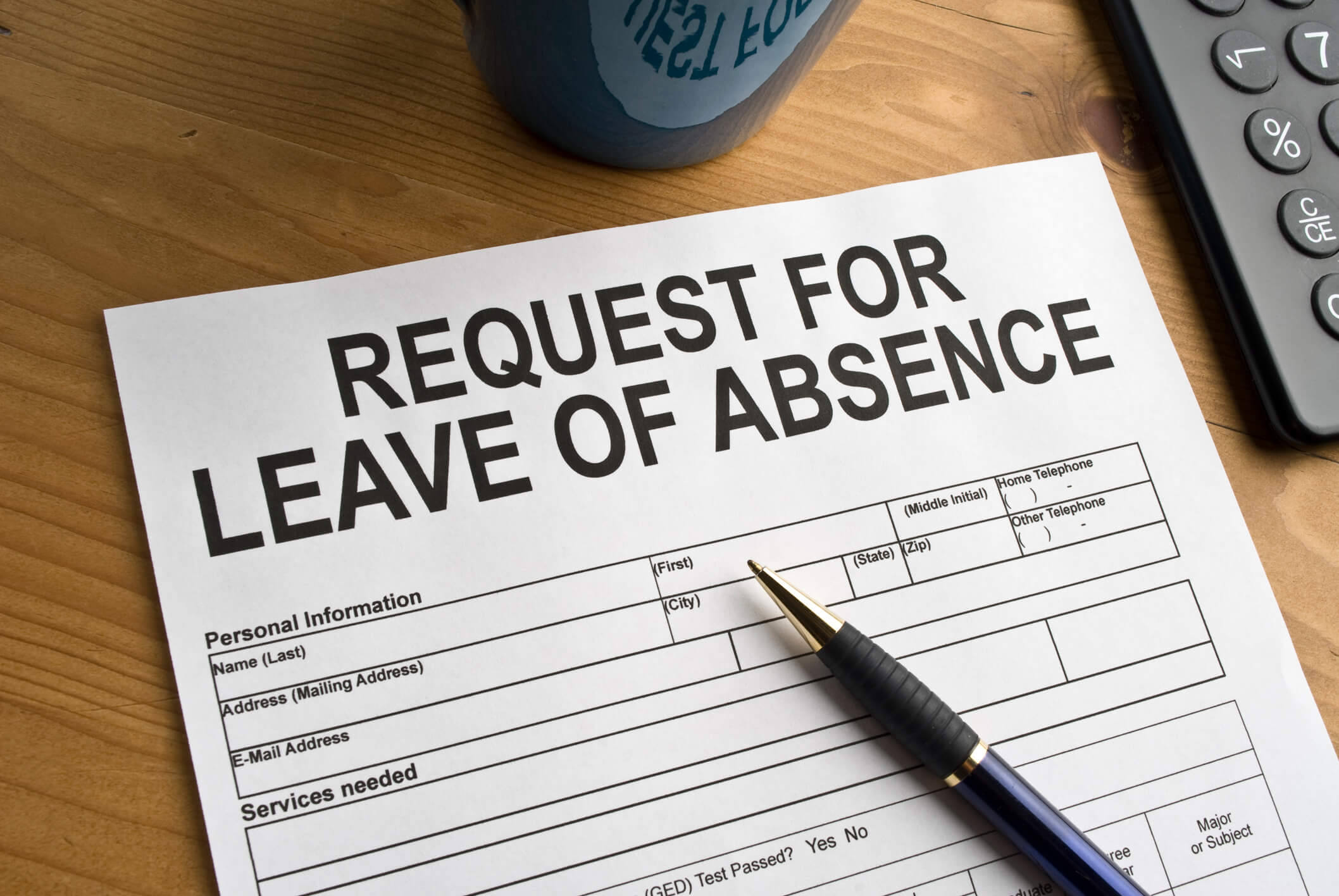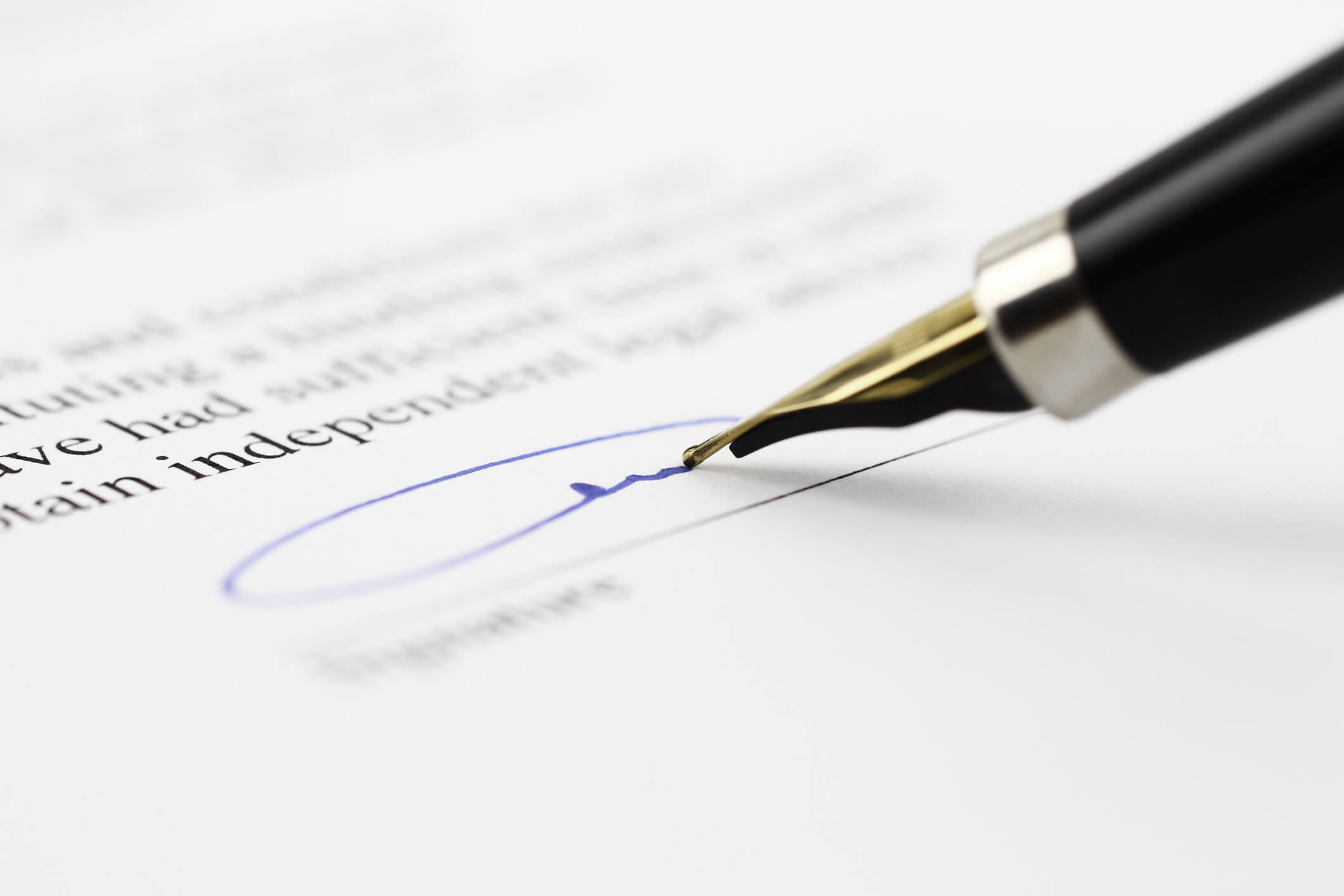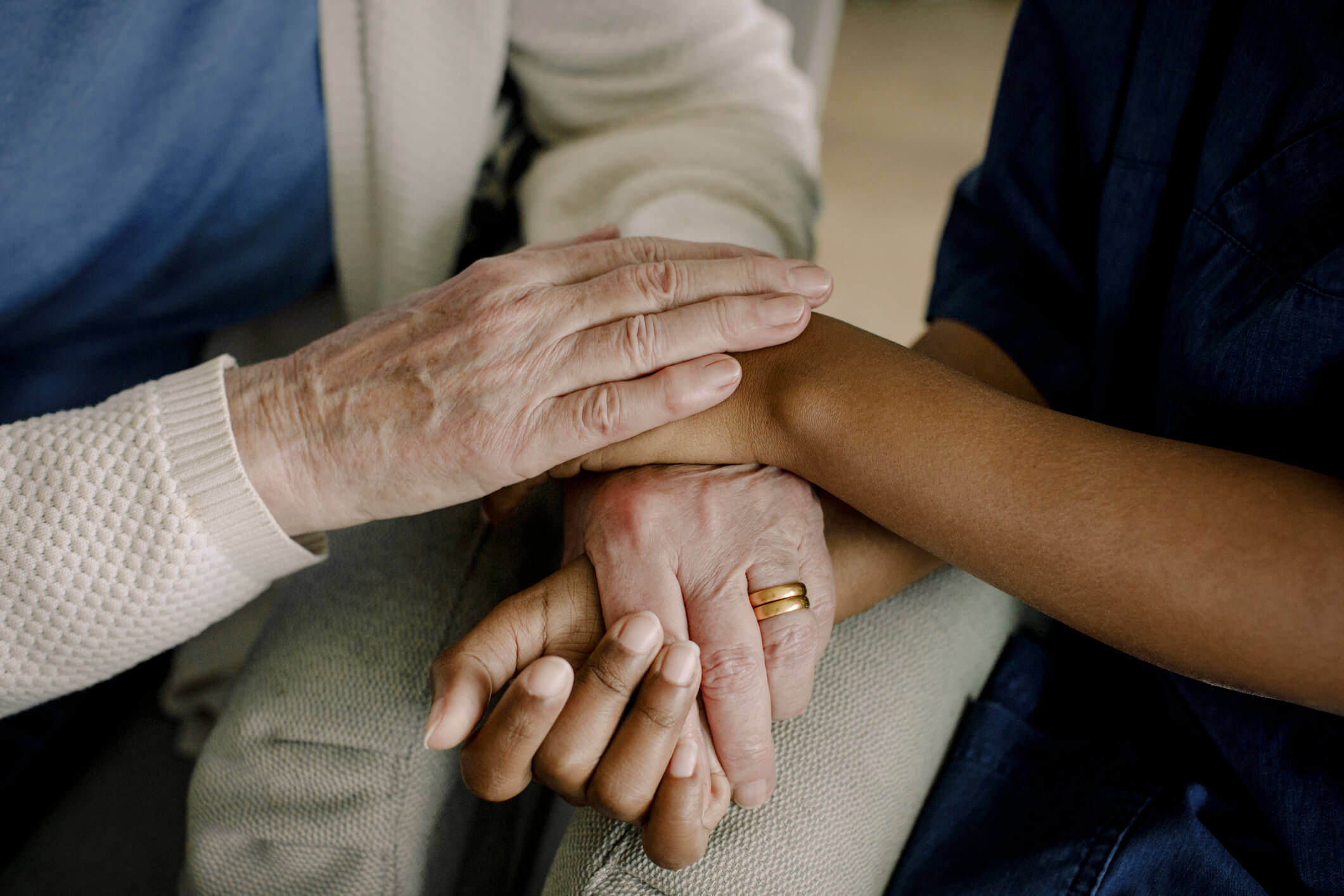For the last several months, employers have been required to learn how COVID-19 spreads, how to maintain or resume safe work environments, and how to navigate a complex web of new and existing laws and regulations implicated by the pandemic. Employers have also had to contend with a growing wave of COVID-19–related employment litigation and agency actions. Below are answers to a number of questions that employers may have regarding liability and litigation as businesses are reopening.
Analysis of COVID-19–Related Employment Litigation
[od_accordion title=”Question 1. What are the types of claims employers may face related to COVID-19?”]
Answer 1. Based on the latest court filings, employers can expect the following types of COVID-19–related claims:
| Types of Claims | Examples |
| Whistleblower / Retaliation/Wrongful Discharge |
|
| Unsafe Working Conditions |
|
| Disability Discrimination |
|
| Title VII – Discrimination | |
| Title III – Disability Access | |
| Family and Medical Leave Act (FMLA) / Families First Coronavirus Response Act (FFCRA) |
|
| Wage and Hour |
|
| Reductions in Force (RIF) / Worker Adjustment and Retraining Notification Act (WARN) |
|
| Workplace Safety and Health / Occupational Safety and Health Act of 1970 (OSH Act) |
|
| Consolidated Omnibus Budget Reconciliation Act of 1985 (COBRA) |
|
| Employee Retirement Income Security Act of 1974 (ERISA) | |
| Traditional Labor Relations / National Labor Relations Act (NLRA) |
|
| Data Privacy/Technology |
|
| Other Claims |
|
[/od_accordion]
[od_accordion title=”Q2. What types of claims have been filed around the country?”]
A2. A review of court filings in the United States from late March 2020 through June 4, 2020 shows numerous employment lawsuits based on COVID-19–related claims that fall into the broad categories set forth in the following graph. Employment related claims are increasing at a rapid pace each week.
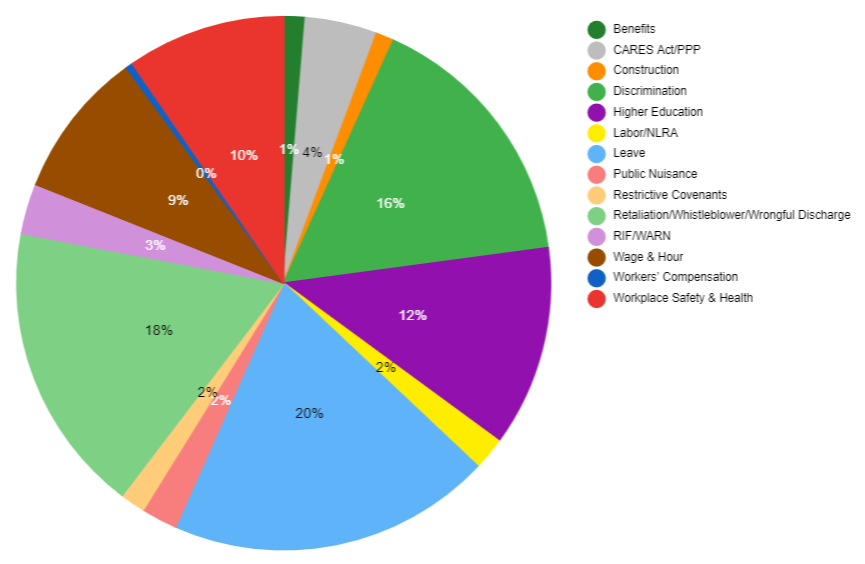
The most common claims continue to relate to safety in the workplace, failure to provide PPE, and retaliation. Many of the related claims overlap and allege complaints about reports of unsafe workplaces and adverse action resulting therefrom.[/od_accordion]
[od_accordion title=”Q3. Are there “hot spots” for COVID-19 litigation popping up in certain areas of the country?”]
A3. Yes. Hot spots of litigation activity related to employment-based COVID-19 claims are popping up in various parts of the country. At this time, the greatest number of claims are generally being filed in California, in states with larger rates of infection, and in states that have reopened quickly.
Given that the foregoing summary relates only to filings during a time when most states had shelter-in-place or stay-at-home orders, and many employers were either not operating or only partially operating, it is likely that these types of lawsuits will increase dramatically in the coming weeks.[/od_accordion]
Analysis of COVID-19–Related Agency Filings Nationwide
Not only is COVID-19 litigation on the rise, but recent data indicates that agency actions are also increasing, in some cases exponentially.
[od_accordion title=”Q4. Are certain industries receiving more lawsuits than others?”]
A4. Lawsuits have hit all industries. The highest number of claims have occurred in the healthcare, hospitality, professional services, retail, and manufacturing industries.[/od_accordion]
Analysis of COVID-19–Related Agency Filings Nationwide
Not only is COVID-19 litigation on the rise, but recent data indicates that agency actions are also increasing, in some cases exponentially. Further, on August 3, 2020, the U.S. Equal Employment Opportunity Commission (EEOC) announced it will again start issuing right to sue letters. The EEOC must issue a right to sue letter for an individual to bring a claim under Title VII of the Civil Rights Act. Once the agency again begins to issue the right to sue letters, additional case filings are expected.
Occupational Safety and Health Administration (OSHA)
[od_accordion title=”Q1. How significant is the uptick in complaints received by OSHA or other similar state agencies related to safety in workplace due to COVID-19?”]
A1. OSHA is tracking COVID-19 inspection and enforcement statistics. Between February 1, 2020 and August 25, 2020, OSHA jurisdictions received 9,526 COVID-19–related complaints and referrals closing 7,575 with 1,915 still open. State Plan jurisidictions have had significantly more complaints and referrals totaling 26,539 with 16,285 closed and 10,254 still open.
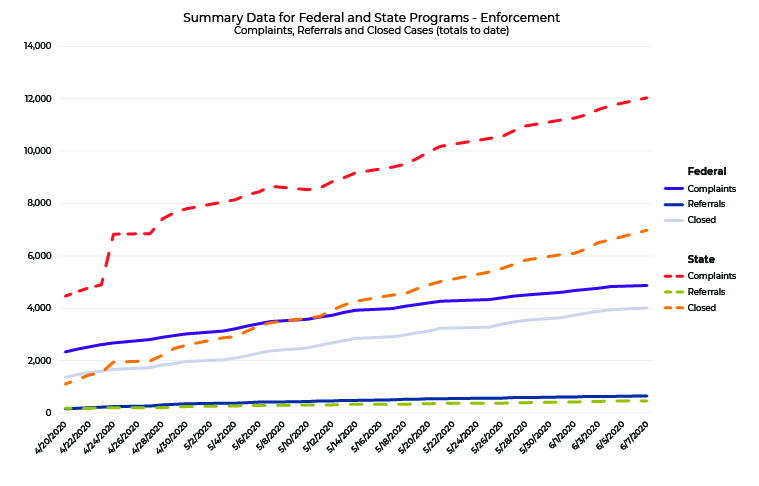
[/od_accordion]
[od_accordion title=”Q2. Are there any industry or timing trends in the OSHA complaints?”]
A2. Yes. The largest number of complaints filed with OSHA or state agencies have consistently related to hospitals, nursing homes, and post offices. Retailers, grocers, restaurants, and other public-facing businesses have received the second-highest percentage of complaints with construction and warehouse facilities following closely behind.[/od_accordion]
[od_accordion title=”Q3. Has there been a spike in any types of inspections?”]
A3. Yes. Through August 25, 2020, OSHA has conducted 941 COVID-19 inspections with the overwhelming majority in the “fatality/catastrophe” category. State Plans have conducted 2,076 COVID-19 inspections with the majority of the inspections arising out of “complaints” (842) from employees and “referrals” (399) from other agencies including health departments. [/od_accordion]
[od_accordion title=”Q4. Have the increased inspections resulted in an increase in safety-related citations?”]
A4. The first of what will likely be more COVID-19–related OSHA citations was issued on May 15, 2020, by Oregon’s state OSHA plan, where a beauty shop very publicly had refused to comply with the governor’s executive order requiring closure. The citation was classified as willful and was accompanied by a $14,000 proposed penalty. Oregon OSHA issued the citation under ORS 654.022 (“Duty to comply with safety and health orders, decisions and rules”), which requires compliance with health and safety orders relating to or affecting safety and health in employment or places of employment. Since this first citation, various industries have received citations particularly in health care, manufacturing (including food processors), and other industries. The citations are based on existing health and safety standards as well as General Duty Clause citations.[/od_accordion]
[od_accordion title=”Q5. Has OSHA issued any enforcement guidance related to COVID-19?”]
A5. Yes. OSHA issued Updated Interim Enforcement Response Plan for COVID-19 effective May 26, 2020, that provides instructions and guidance to area offices and compliance safety and health officers (CSHOs) for handling COVID-19-related complaints, referrals, and severe illness reports. This guidance is instructive for employers to understand OSHA’s enforcement and inspection priorities and procedures as well as standards at issue and citation guidance. OSHA will continue to prioritize COVID-19 related complaints and referrals based on the level of community transmission in each jurisdiction and the circumstances involved with each report.
OSHA also issued Revised Enforcement Guidance for Recording Cases of COVID-19 effective May 26, 2020, concerning the recordkeeping requirements of 29 C.F.R Part 1904 pertaining to the recording of occupational illnesses, specifically cases of COVID-19. Under OSHA’s recordkeeping requirements in 29 C.F.R. Section 1904, coronavirus is a recordable illness, and an employer is responsible for recording a coronavirus case, if the case:
- is confirmed as a coronavirus illness;
- is work-related as defined by 29 C.F.R. Section 1904.5; and
- involves one or more of the general recording criteria in 29 C.F.R. Section 1904.7, such as medical treatment beyond first aid or days away from work.
Under the new policy, OSHA will enforce the recordkeeping requirements of 29 C.F.R. Section 1904 in cases of employee coronavirus illnesses that are work-related. OSHA’s guidance emphasizes that an employer must make reasonable efforts, based on the evidence reasonably available to it, to ascertain whether a particular case of coronavirus is work related; if the employer evidences good faith in doing so, OSHA will exercise enforcement leniency. Our analysis of this new policy can be found here.[/od_accordion]
[od_accordion title=”Q6. Can an employee sue his or her employer for violating OSHA standards?”]
A6. OSHA does not create a private right of action that would allow employees to sue a company for injuries or illness (COVID-19) caused by a violation of the Occupational Safety and Health Act of 1970 (OSH Act) or OSHA standards. On the other hand, OSHA regulations do not affect employee rights under state workers’ compensation laws to pursue lawsuits based on alleged violations of rights created by state statutes or common law. Evidence of OSHA violations, however, may be admissible as evidence in such suits depending on the jurisdiction. In tort lawsuits, evidence of an OSHA violation is normally allowed to show “some evidence” of negligence, while other courts have held that an OSHA violation constitutes “per se” negligence.[/od_accordion]
[od_accordion title=”Q7. Can an employee bring a complaint related to safety issues at his or her workplace?”]
A7. There are two types of employee complaints under OSHA:
- Section 11(c) retaliation complaints under the OSH Act, which the U.S. Department of Labor can enforce through a civil enforcement action in federal district court; and
- A safety or health complaint by an employee where OSHA can dispatch an inspector to investigate and potentially issue a citation against the employer for any violations.
[/od_accordion]
[od_accordion title=”Q8. What is the OSHA general duty clause and what is the risk of a violation based on safety policies that are not followed?”]
A8. The General Duty Clause is found in Section 5(a)(1) of the OSH Act, 29 U.S.C. Section 654(a)(1), and it requires each employer to (1) “furnish to each of [its] employees employment and a place of employment which are free from recognized hazards that are causing or are likely to cause death or serious physical harm to his employees,” and (2) “comply with occupational safety and health standards promulgated under” the OSH Act. State OSHA plans have similar requirements.
There have been a handful of general duty clause citations in some jurisdictions based on violations of social distancing and other general infection prevention guidance. OSHA’s Revised Enforcement Guidance for Recording Cases of COVID-19 describes the factors a CSHO needs to consider before issuing a COVID-19 based General Duty Clause citation and the use of CDC guidance to assess potential workplace hazards as follows:
General Duty Clause. If deficiencies not addressed by OSHA standards or regulations are discovered in the employer’s preparedness for controlling elevated occupational exposure risk for SARS-CoV-2, and guidance is available (e.g., CDC), follow the FOM guidance for obtaining evidence of a potential general duty clause violation, including the four required elements: (1) The employer failed to keep the workplace free of a hazard to which employees of that employer were exposed; (2) The hazard was recognized; (3) The hazard was causing or was likely to cause death or serious physical harm; and, (4) There was a feasible and useful method to correct the hazard.
Unless the case file evidence establishes that all four of the above elements, the Area Office should issue a hazard alert letter (HAL) recommending the implementation of protective measures that address SARS-CoV-2 hazards. For example, if there is no evidence that an employee was potentially exposed to the virus in the workplace, then the first element is not met. See Attachment 3 for a sample HAL.
Use of CDC recommendations. The most current CDC guidance should be consulted in assessing potential workplace hazards and to evaluate the adequacy of an employer’s protective measures for workers. Where the protective measures implemented by an employer are not as protective as those recommended by the CDC, the CSHO should consider whether employees are exposed to a recognized hazard and whether there are feasible means to abate that hazard.
OSHA’s burden of proof on a General Duty Clause citation is rigorous and each of the four required elements described above must be satisfied to sustain a General Duty Clause citation.
Also, there may be some risk to employers for a General Duty Clause citation for a failure to implement a company’s safety procedures. In May 2020, , the U.S. Court of Appeals for the District of Columbia Circuit issued a decision that should be of concern to every employer and safety professional. The case, BHC Northwest Psychiatric Hospital, LLC v. Secretary of Labor, 951 F.3d 558 (D.C. Cir. 2020), involved an employer that had ambitious but unimplemented requirements in its written safety procedures—the lack of implementation in large part caused the employer to be found guilty of a violation of the General Duty Clause. This decision is a reminder to employers to be vigilant in following through on safety procedures adopted in the workplace.[/od_accordion]
[od_accordion title=”Q9. Has an emergency temporary standard (ETS) been issued by OSHA or state plans related to COVID-19?”]
A9. OSHA has not issued an ETS, however, some state plans have taken steps to adopt an ETS, which is described below.
Federal OSHA
OSHA has not issued an ETS. In addition, an effort to compel OSHA to issue an ETS was rejected by the D.C. Circuit Court of Appeals. In re: American Federation of Labor and Congress of Industrial Organizations, No. 20-1158 (June 11, 2020)
(The court held that “[t]he OSHA’s decision not to issue an ETS is entitled to considerable deference. In light of the unprecedented nature of the COVID-19 pandemic, as well as the regulatory tools that the OSHA has at its disposal to ensure that employers are maintaining hazard-free work environments, the OSHA reasonably determined that an ETS is not necessary at this time.”) However, OSHA has published general and interim guidance(not an ETS) for all workplaces and specific industries in light of COVID-19 that it describes as “good practice”and includes a description of the “hierarchy of controls, including engineering controls, administrative controls, safe work practices, and PPE” incorporating recommendations from the CDC and U.S Food and Drug Administration depending on the industry. This guidance is similar to the general and industry specific recommendations issued in most states.
Virginia
The Virginia Department of Labor and Industry’s Safety and Health Codes Board approved an ETS for COVID-19 to be enforced by the Virginia Occupational Safety and Health (VOSH) program. Virginia is the first state to adopt a specific standard intended to protect workers and “to control, prevent, and mitigate the spread of [COVID-19]” in the workplace. Virginia’s ETS went into effect on July 27, 2020. It includes an extensive list of requirements that all employers within VOSH’s jurisdiction must follow, regardless of the level of exposure to COVID-19, and additional requirements for employers based on exposure level. The standard will expire after six months or “upon expiration of the Governor’s State of Emergency,” but the Board will be considering the adoption of a permanent standard during this same time period. Our Workplace Safety and Health Practice Group’s analysis of Virginia’s ETS is here.
Oregon
On August 17, 2020, the Oregon Occupational Safety and Health Administration (Oregon OSHA), the state plan responsible for overseeing workplace safety and health in the state of Oregon, released a draft COVID-19 temporary standard. Following Virginia’s lead, Oregon will become the second state in the nation to adopt a specific standard intended to protect workers from COVID-19 exposure. The draft is not a final version, and Oregon OSHA invited stakeholders to provide comments as soon as possible, but by no later than August 31, 2020, with planned adoption of a final rule by September 14, 2020. Our Workplace Safety and Health Practice Group is monitoring this legislation and provides a summary of this new initiative here.
[/od_accordion]
Equal Employment Opportunity Commission (EEOC)
[od_accordion title=”Q1. Have any timelines changed in relation to agency charges as a result of COVID-19?”]
A1. Filing deadlines with the EEOC have not been affected by COVID-19. Charges must still be filed with the EEOC within the applicable timeframe (300 days or 180 days depending on circumstances).
The number of agency charges related to COVID-19 filed with the EEOC since February 2020 has not been released.[/od_accordion]
[od_accordion title=”Q2. Has there been a delay in the issuance of right-to-sue letters from the EEOC as a result of COVID-19?”]
A2. In an effort to delay litigation deadlines, the EEOC has unofficially stopped issuing right-to-sue letters amid the COVID-19 pandemic, unless specifically requested by an employee. The EEOC’s issuance of a right-to-sue letter starts a 90-day filing deadline for the employee to bring the lawsuit. The EEOC’s new practice will keep this 90-day clock from starting.
Update: On August 3, 2020, the EEOC announced that it is again issuing right to sue letters.[/od_accordion]
[od_accordion title=”Q3. Has the EEOC filed any litigation related to COVID-19?”]
A3. To date, the EEOC has not filed any COVID-19–related lawsuits on its own behalf. Litigation filed on behalf of individual plaintiffs is reflected in the nationwide litigation tracker above. (See “Analysis of COVID-19–Related Employment Litigation Filed Nationwide,” Q&A 3.)[/od_accordion]
COVID-19–Related Legislation
The U.S. Chamber of Commerce has listed as a top legislative goal a broad safe harbor from COVID-19 related lawsuits for businesses tied to guidelines set out by the CDC and state health authorities. Opponents take the position that such safe harbors are unnecessary and would be overly broad. While the federal adoption of a liability shield is debated in Washington, D.C., states have begun to take action to help businesses mitigate the potential exposure.
Litigation Shield Legislation
[od_accordion title=”Q1. Are states acting to protect employers from COVID-19–related litigation?”]
A1. Yes. Ogletree Deakins has developed a tracking tool related to COVID-19 “litigation shield” legislation around the country. The tool can be accessed via the Ogletree Deakins Coronavirus Litigation Resource page.
The litigation shield tracking tool details newly enacted laws and pending legislation (as well as executive orders). The tracking tool also provides links to these developments and other useful materials. To date, the states highlighted in the map below have enacted liability shield litigation or have legislation pending. (Please note that legislation is considered pending even if it has passed both houses and is awaiting gubernatorial signature). States with current executive orders are also noted.
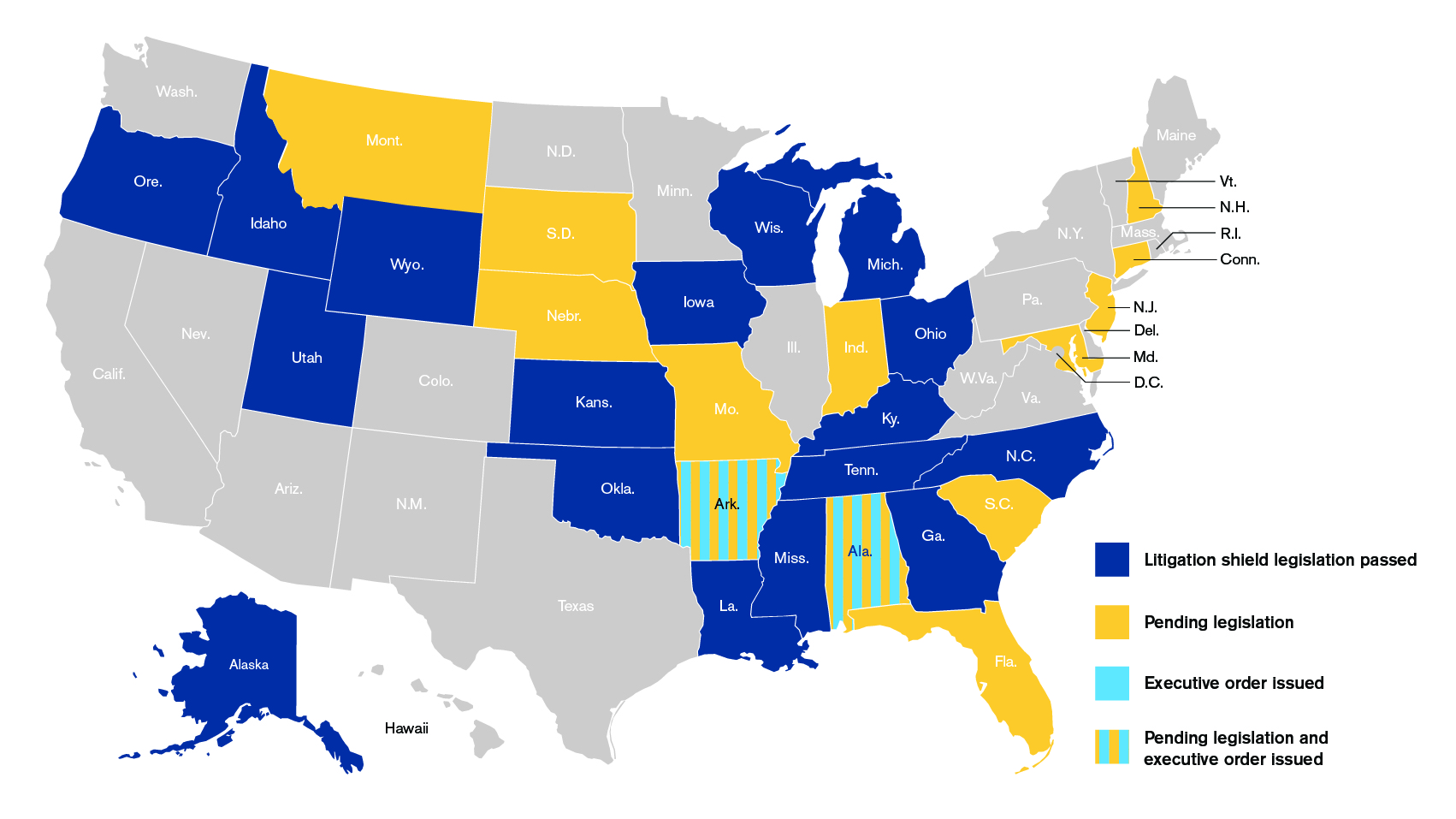 [/od_accordion]
[/od_accordion]
[od_accordion title=”Q2. Is liability shield protection limited to certain industry groups?”]
A2. Each state has passed different legislation. Many states have passed laws designed to protect healthcare providers. Those laws are not addressed in the liability shield tracking tool because they are heavily associated with medical malpractice claims. Most of the “non-healthcare oriented” liability shield laws are not industry specific. Instead, they focus on broad categories of activities, such as maintaining premises, offering services, selling products, and employing individuals, and are for the most part drafted to be laws of general application.[/od_accordion]
[od_accordion title=”Q3. What factors are used in defining the parameters of liability shield defenses?”]
A3. Again, the details of the legislation vary from state to state. Most legislation either precludes liability unless a form of heightened culpability (such as gross negligence) is proven or the legislation conditions protection on adherence to specified guidelines.[/od_accordion]
[od_accordion title=”Q4. What proactive steps can an employer take to enjoy liability shield protection?”]
A4. While varied from state to state, the common theme running through most current legislation is that good actors should be protected. Employers may want to follow and keep current on CDC, OSHA, and other state guidelines for safe operation. Whether there is a need to affirmatively demonstrate compliance, or to defend against an allegation of heightened negligence, following official recommended practices will likely be beneficial. Employers may want to consider keeping good records of those efforts.[/od_accordion]
[od_accordion title=”Q5. What if an employer operates in a state that has not passed liability reform related to COVID-19?”]
A5. The same principles hold in the case of operations located in a state that has not yet passed a liability shield law, or in which none is yet pending. In all likelihood, future legislation will follow the same general pattern as that which already exists. Additionally, legislation may be designed to be retroactive, so precautions taken now may be pertinent to invoking defenses under future legislation.[/od_accordion]
Workers’ Compensation Legislation
[od_accordion title=”Q1. Are states revising workers’ compensation rules in response to COVID-19?”]
A1. Yes. Ogletree Deakins has developed a tracking tool related to COVID-19 workers’ compensation legislation around the country. The tool can be accessed on the Ogletree Deakins Coronavirus Litigation Resource page.
The workers’ compensation tracking tool details proposed legislation, enacted legislation, and emergency rules. The tracking tool also provides links to these developments, state workers’ compensation websites, and other useful materials. To date, the following states have passed legislative reforms or emergency rules related to workers’ compensation and COVID-19. In addition, the chart below shows the states in which legislation is pending.
 [/od_accordion]
[/od_accordion]
[od_accordion title=”Q2. Are states issuing other guidance related to COVID-19 and workers’ compensation?”]
A2. Yes. Some states have issued emergency rules. Some state agencies have also issued substantive policy statements or guidance advising that claims handlers may not categorically deny COVID-19 claims and how to evaluate COVID-19 claims. The workers’ compensation tracker identifies these states as well.[/od_accordion]
[od_accordion title=”Q3. Is workers’ compensation reform limited to certain industry groups?”]
A3. Each state has passed different legislation. Some states have limited the workers’ compensation expansion to health care and emergency response workers, but other states do not have this limitation and expand presumptive coverage to more classes of workers, primarily those workers deemed to work for essential businesses defined by a state’s executive order(s).[/od_accordion]
[od_accordion title=”Q4. What impact will workers’ compensation reform have on litigation in the workers’ compensation system?”]
A4. The impact of workers’ compensation reform on COVID-19 litigation depends on the type of reform passed. Most states that have passed reforms have included presumptions that an employee contracted COVID-19 at work. The presumption shifts the burden from the employee to prove the virus was contracted at work to the employer to prove that the virus was not contracted at work.[/od_accordion]
[od_accordion title=”Q5. What factors are considered when determining whether employees and employers have met their respective burdens?”]
A5. Determining if an employee is eligible for workers’ compensation benefits if he or she contracts COVID-19 is not a clear-cut analysis, so it would be prudent to evaluate claims based on the facts and circumstances under the applicable state law. If the employee is a health care worker, first responder, or essential employee required to work during the pandemic, the answer is more likely to be “yes” (subject to variations in state laws regarding coverage and an employee’s burden of proof). For other categories of employees, a compensable workers’ compensation claim is possible (but unlikely), though the analysis is very fact-specific. Of course, in states that have implemented presumptions, coverage is more likely. Further, there are numerous novel pandemic factual scenarios (e.g., teleworking arrangements) for which workers’ compensation compensability outcomes currently are unknown.
As a general matter, in order to qualify for workers’ compensation benefits, most states require an employee to prove that an injury occurred at work and was proximately caused by his or her employment. Importantly, it is unlikely that contracting COVID-19 would be considered an injury; instead, it is likely that the issue will be analyzed under state law to determine if the injury is an occupational disease. To be an occupational disease (again, subject to state law variations), an employee generally must show two things:
- The illness or disease is occupational, meaning that it arose out of and was contracted in the course and scope of employment
- The illness or disease arose out of or was caused by conditions peculiar to the work which created a risk of contracting the disease in a greater degree and in a different manner than in the public generally
The general test for determining whether an injury “arises out of and in the course of employment” is whether the employee was exposed to harm (in this case, the virus) while involved in some activity for the benefit of the employer.
Compensability for a workers’ compensation claim will be determined on a case-by-case basis. The key consideration generally will be whether the employee contracted the virus while working and whether the exposure to the disease was “peculiar” to the employment. Even if the employer takes all of the right steps to protect employees from exposure, a compensable claim may be determined where the employee can show that he/she contracted the virus after an exposure, the exposure was peculiar to the work, and there are no plausible alternative means of exposure demonstrated.[/od_accordion]
[od_accordion title=”Q6. What steps can an employer take to prepare for workers’ compensation claims related to COVID-19?”]
A6. Employers can prepare for workers’ compensation claims by following and keeping up to date on CDC, OSHA, and other state guidelines for a safe workplace. In addition, employers can prepare by keeping good records and illustrating the steps taken to prevent infection from getting into and spreading in the workplace.[/od_accordion]
[od_accordion title=”Q7. Will all claims be litigated by the workers’ compensation commissions?”]
A7. Each state provides exclusions from workers’ compensation claims, the most prominent being if an employer acts with intent to harm. It is anticipated that claims will be filed in state courts around the country and an affirmative defense of workers’ compensation exclusivity will need to be raised. How each state court system will deal with this type of challenge to workers’ compensation exclusivity is still unclear. Depending on the state system, this could result in costly defenses for employers as they seek to show an absence of intent to harm in state court settings before their cases are moved to workers’ compensation arenas where it can be shown the virus was or was not contracted at work. Generally, courts give strong deference to the workers’ compensation bar. But it remains to be seen how courts will analyze novel claims filed for COVID-19 contraction or exposure.[/od_accordion]
[od_accordion title=”Q8. What if an employer operates in a state that has not passed liability reform related to COVID-19?”]
A8. Employers in states that have not implemented any changes to their workers’ compensation laws may find it beneficial to continue to analyze whether a COVID-19–related exposure is compensable under their states’ existing statutory definitions and administrative guidance.[/od_accordion]
Mitigation Strategies
[od_accordion title=”Q1. What can an employer do to mitigate the risk of COVID-19–related employment lawsuits?”]
A1. An employer may want to consider the following actions to mitigate the exposure to COVID-19–related employment claims:
- Ensuring relevant policies are up to date, including, but not necessarily limited to, policies related to non-harassment, anti-discrimination, anti-retaliation, the FMLA, the Emergency Paid Sick Leave Act and the Emergency Family and Medical Leave Expansion Act under the FFCRA (if fewer than 500 employees), interactive process/reasonable accommodation issues, and remote work
- Educating managers, supervisors, and human resources professionals on the relevant policies and steps to take if an employee requests to utilize the policies and/or expresses concerns regarding noncompliance
- Preparing a COVID-19 workplace safety plan, communicating the plan to all employees, ensuring compliance with the plan, investigating and addressing any reported concerns, and documenting the investigation process and outcome
- If conducting health screenings, temperature checks, and/or other testing such as viral testing, antibody testing, or oxygen testing, ensuring compliance with social distancing requirements, confidentiality with regard to any records created, and the mandates of applicable privacy laws (note that restrictions on permissible testing exist in some jurisdictions)
- Documenting steps taken after an employee reports a positive and/or presumptive COVID-19 diagnosis and complying with all state guidelines and CDC recommendations on quarantine timeframes and return-to-work parameters
- If adjusting compensation, providing notice of changes as required by applicable state laws
- If reducing the workforce, providing appropriate notices and ensuring selection criteria is nondiscriminatory
- Staying abreast of new laws and other legislative developments
[/od_accordion]
Ogletree Deakins has launched the COVID-19 Litigation Practice Group to track and respond to COVID-19 related litigation. Ogletree Deakins will continue to monitor and report on developments with respect to the COVID-19 pandemic and will post updates in the firm’s Coronavirus (COVID-19) Resource Center as additional information becomes available.
Important information for employers is also available via the firm’s webinar programs. The COVID-19 Litigation Practice Group will present a COVID-19 webinar series throughout 2020 to discuss trends related to COVID-19 employment litigation.









